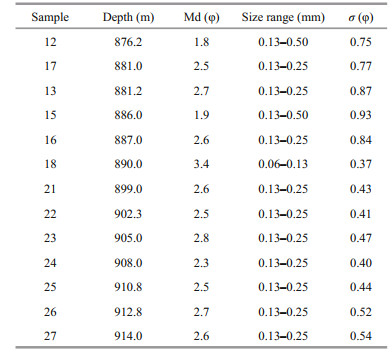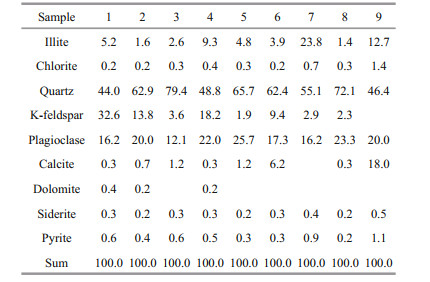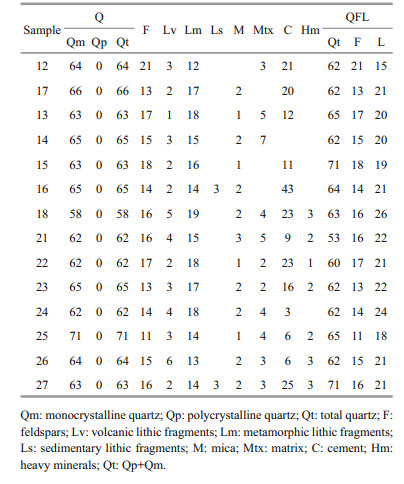Institute of Oceanology, Chinese Academy of Sciences
Article Information
- HUANG Yuxiao, GUO Xingwei, ZHANG Xunhua, CAI Laixing
- Geochemistry of the upper Permian sandstones in the Dalong Formation in the South Yellow Sea Basin, East China: implications to provenance, weathering, and tectonic setting
- Journal of Oceanology and Limnology, 39(3): 814-829
- http://dx.doi.org/10.1007/s00343-020-0155-x
Article History
- Received Apr. 16, 2020
- accepted in principle Jul. 13, 2020
- accepted for publication Jul. 30, 2020
2 Qingdao Institute of Marine Geology, Qingdao 266071, China;
3 Laboratory for Marine Mineral Resources, Pilot National Laboratory for Marine Science and Technology(Qingdao), Qingdao 266237, China;
4 Institute of Oceanology, Chinese Academy of Sciences, Qingdao 266071, China
The geochemical composition of sedimentary rocks is influenced by several factors, such as the nature of the parent rocks, tectonic setting, intensity of weathering, distance of transport, transport agent, and diagenetic history (McLennan et al., 1993). The petrography and geochemistry of marine sediments have been widely used to identify provenances (Armstrong-Altrin et al., 2015; Zaid, 2015a, b; Tawfik et al., 2017a, b), evaluate the weathering intensity of source areas (Tawfik et al., 2011; Tao et al., 2014), and explore tectonic settings and depositional environments (Tawfik et al., 2012; Armstrong-Altrin, 2015; Verma and Armstr ong-Altrin, 2016; Etemad-Saeed et al., 2016). Compared with other factors, source rocks mainly control the geochemical compositions of sedimentary rocks. Then, the tectonic setting of the sedimentary materials may also play an important role among the remaining factors because different kinds of source materials and variable chemical characteristics come from different tectonic settings (Bhatia, 1983; Bhatia and Crook, 1986). In addition, other factors, such as weathering intensity, paleoclimate (Berner, 1991; Zachos et al., 1999; Goddéris et al., 2014; Salama and Anand, 2017), transport distance, grain size, separation of transport media, and postdepositional effects (Johnsson and Basu, 1993; McLennan et al., 1993), have unique impacts on the distribution of elements.
The continental shelf of the Yellow Sea is an important part of China's continental shelf. Since the 1960s, studies on the regional geology and environmental geology of the South Yellow Sea have continued. There is a preliminary consensus among researchers on some geophysical aspects, such as gravity and magnetic forces, distribution of sedimentary strata and tectonic evolution of the South Yellow Sea Basin. However, for a long time, the number of drill holes was insuffcient in the South Yellow Sea area. According to statistics, information on Paleozoic strata can be obtained from no more than 8 drill holes in the South Yellow Sea Basin, and the rate of rock core extraction was low until 2015 (Xu et al., 2015). Therefore, exploring the potential of this region for commercial oil accumulations is diffcult, and some Mesozoic-Paleozoic marine strata are questionable. For example, do Permian and Carboniferous strata exist in the South Yellow Sea (Zhang et al., 2009, 2019; Hao et al., 2010; Dai, 2011)? Furthermore, this question is a great obstacle to determining the provenance and weathering of sediments as well as reconstructing the paleoenvironment and paleoclimate of the South Yellow Sea Basin during the Permian.
The CSDP-2 hole (2 843.18 m) is drilled into the Central Uplift, which is located at a structural high point in the South Yellow Sea Basin, and reveals a sedimentary series from the Quaternary; the Mesozoic Triassic; the upper Paleozoic Permian, Carboniferous, and Devonian; to the lower Paleozoic Silurian. These strata greatly aid us in reconstructing the sedimentary characteristics of the element geochemical environment, source-sink system, and weathering processes in the Lower Yangtze Plate (Guo et al., 2017; Zhang et al., 2019).
To date, there remain large gaps in reconstructing the upper Permian geochemical characteristics of the South Yellow Sea Basin. Based on new rock samples, this study aims to explain the chemical weathering process, provenance, tectonic settings, and sedimentary diagenetic environment through a variety of methods, such as rock observation, geochemistry, X-ray diffraction (XRD) analysis, and scanning electron microscopy (SEM). Reconstructing the paleo-geochemical environment and evaluating the resource potential of the South Yellow Sea Basin have great significance.
2 GEOLOGY AND STRATIGRAPHY OF STUDY AREAChina's offshore continental shelf is an important part of the trench-arc-basin system in the western Pacific Ocean, while the South Yellow Sea Basin is a key part of China's continental shelf and an extension of the Lower Yangtze Plate into the ocean (Zhang et al., 2019). The northern boundary of the South Yellow Sea Basin is the Dabie-Sulu orogenic belt; the Tanlu Fault is the western boundary; the land area of the Lower Yangtze Plate forms the southwestern boundary; in the south, the eastern extension of the Jiangshan-Shaoxing fault is the boundary between the South Yellow Sea Basin and the South China block; and the Korean Peninsula marks the eastern boundary (Guo et al., 2017; Cai et al., 2019; Pang et al., 2019).
The South Yellow Sea Basin (Fig. 1) is a multicycle sedimentary basin developed on the basement of pre-Sinian metamorphic rock (Guo et al., 2017; Pang et al., 2017a, b). Since the Sinian, the tectonic processes in the South Yellow Sea Basin could be divided into five stages: 1) Sinian-early Paleozoic craton development; 2) Late Paleozoic-Middle Triassic marine platform development; 3) Late Triassic-Early Cretaceous tectonic denudation; 4) Late Cretaceous-Paleogene fault depression development; and 5) Neogene-Quaternary depression development. According to the sedimentary distribution ranges and stratigraphic development characteristics of the continental fault basin, five secondary tectonic units can be further identified from north to south: the Qianliyan Uplift, the Northern Depression, the Central Uplift, the Southern Depression and the Wunansha Uplift (Hou et al., 2008; Zhang et al., 2013).

|
| Fig.1 Tectonic divisions and borehole locations in the South Yellow Sea Basin (Guo et al., 2017) |
The Central Uplift, located between 34°N and 35°N, is the largest among the five secondary units. It strikes E-W and divides the South Yellow Sea Basin into two terranes. The evolution of the Central Uplift has been influenced by the Yangtze Plate and the South China Plate at the same time (Xu et al., 2019; Zhang et al., 2019). Generally, the Central Uplift was developing with the basin evolution, and the tectonic activity was relatively stable from the late Sinian to Early Triassic. Since the Middle Triassic, the South Yellow Sea Basin has been uplifted and denuded by tectonic movement. After the Late Cretaceous, it became a fault basin because of tensile stress (Zhang et al., 2019).
Previous studies have shown thick marine sedimentary strata in the Central Uplift. The Mesozoic strata in the CSDP-2 drill hole (Fig. 2) are overlain by an unconformity at a depth of 629.0 m. The strata from top to bottom are the Lower Triassic Qinglong Formation (T1q), the upper Paleozoic Dalong Formation (P3d), the middle Permian Longtan Formation (P3l) and Gufeng Formation (P2g), the lower Permian Qixia Formation (P1q), the upper Carboniferous Chuanshan Formation (C3c) and Huanglong Formation (C2h), the lower Carboniferous Gaolishan Formation (C1g), the Devonian Wutong Formation (D3w), Leigutai Formation (D3l), Guanshan Formation (D3g), the lower Silurian Maoshan Formation (S1m), Fentou Formation (S1f), Houjiatang Formation (S1h), and Gao Jiabian Formation (S1g) (Guo et al., 2017; Pang et al., 2019; Cai et al., 2019, 2020).

|
| Fig.2 Stratigraphic column of the upper Permian Dalong Formation N9 well (in the northern Jiangsu Province) (Wang et al., 2014); CSDP-2 (in the Central Uplift of the South Yellow Sea Basin). |
The Dalong Formation is widely distributed in the Middle and Lower Yangtze Plate, and conforms to the Longtan Formation (Wujiaping Formation) of the lower strata and a thickness of 28-70 m and changes little. In the Nanzhang-Jiujiang-Changzhou (Jiangsu Province) and Sangzi-Enshi areas (Hunan Province), the Dalong Formation is mainly composed of gray black to black thin-bedded siliceous rock, siliceous shale, and carbonaceous shale, interspersed with local thin layers of marl. The main fossils include Pseudotirolites sp., Rotodiscoceras sp., and Pleuronodoceras sp. The Dalong Formation is mostly within the Qianshan-Jiangshan area, the southeastern China. It is mainly composed of thin to moderately thick variegated siltstone, fine sandstone, siliceous siltstone, and mud shale. In addition, the common fossils are brachiopods such as Chonetes sp., Crurithyris sp., Dictyoclostus sp., and Linoproductus sp., and ammonites Pseudotirolites sp. (Jiang et al., 1994).
The Dalong Formation is also found in the Southern Depression of the South Yellow Sea Basin with a sedimentary thickness of 118 m. The rock types in the upper part are calcareous siltstone, gray and gray black sandstone, and the lower part consists of gray silty mudstones (Wang et al., 2014). In the comprehensive continental and marine strata, the Dalong Formation has obvious temporal heterogeneity in sedimentary strata in different regions. The marine strata are mainly composed of sandstones, sandy mudstones and other clastic rocks. However, the terrestrial strata are mainly composed of siliceous rocks, siliceous shales, and carbonaceous shales.
By observing the core and comparing it with the strata in other Lower Yangtze areas (Xu, 1997; Liang et al., 2008; Wang et al., 2014), the core interval from 860-915 m consists of P3d strata, which can be divided into two sections: the upper part is mainly white bioclastic dolomite with a small amount of fine sandstone; the lower section is mainly gray fine sandstones and mudstones. At the same time, conodonts, such as the Clarkina changxingensis-C. deflecta-Cyini Clarkina wangi-C. subxarinata bioassemblage zone belonging to the Changhsingian Stage, have been found. The Dalong Formation is thought to correspond to the Changhsingian Stage in the international standard strata based on the combination of lithostratigraphy and micropaleontological fossils (Jin et al., 2000).
3 MATERIAL AND METHODBased on petrographic observations, the sample collection and experimental tests focused on the lower part of the Dalong Formation.
Fifteen thin sections were selected for observation under the microscope, and nine sandstone samples were selected for testing by XRD analysis. The XRD instrument was a D/MAX-2500 (Cu target; graphite monochromator; tube pressure/tube flow at 40 kV/150 mA; continuous scanning, scanning speed of 8°/min). Thirteen samples were chosen for analysis by SEM to observe the mineral morphology, and the experimental instrument was a Hitachi S4800 cold field emission system.
Nine sandstone samples were selected for geochemical testing. Fresh rock samples went through physical crushing, and the rest passed through a 200-mesh screen mesh. After filtration and drying, samples (30-40 μg) were heated to 600 ℃ to calculate the loss on ignition (LOI). The analysis of major and trace elements was carried out by the Experiment and Testing Center of Marine Geology, the Ministry of Land and Resources. The major elements were measured by X-ray fluorescence spectrometry (AiosPW4400 X-ray fluorescence spectrometer). The trace elements and rare earth elements were measured by inductively coupled plasma mass spectrometry (ICP-MS) (Thermo-X-Series-2 2 plasma mass spectrometer). The procedure and operation were based on GB/T20260-2006 and DZG20.01-1991, and the analytical accuracy was better than 5%.
4 RESULT 4.1 Grain size characteristicsThe grain sizes (Table 1) range from 1.8 to 3.4 φ, implying that the grains are fine to medium. The standard deviation is 0.40-0.93 φ (avg: 0.67 φ), indicating that the sorting in the sandstone is moderate-good. In addition, the sorting of the lower part of sandstone is obviously better than that of the upper part.
Based on the XRD results (Table 2), quartz dominates in the composition of rock-forming minerals, ranging from 44.0% to 79.4% (average: 59.7%). In addition to quartz, the second main mineral is feldspar, including K-feldspar and plagioclase, ranging 15.7%-48.8%.
The main clay minerals include illite, chlorite, and kaolinite. Illite is the most common clay minerals in the identified samples and has often been formed by weathering or alteration of mica and other minerals. Other minerals in samples are quite different; although chlorite in one sample is greater than 1%, the amounts in other samples are between 0.2% and 0.7% (average: 0.4%). In addition to clay minerals, the remaining components are identified as calcite, dolomite, siderite, and pyrite. Some minerals such as dolomite, siderite, and pyrite in the samples are not detected or account for less than 1%.
Compared with K-feldspar, plagioclase with low weathering resistance dominates most of the samples. This result indicates the existence of weak weathering in the source rock area, short transport distance or lack of reformation after burial diagenesis because of the low carbonate content (Armstrong-Altrin et al., 2001). The absence of montmorillonite and dominance of illite indicate that settlement during the depositional process may have been rapid for Dalong Formation sandstones.
4.3 PetrographyAccording to the thin sections, the framework grains of the Dalong Formation are monocrystalline quartz (Qm), K-feldspar (KF), plagioclase (PF), and lithic fragments, including volcanic fragments (Lv), metamorphic fragments (Lm), and sedimentary fragments (Ls) (Table 3). Cracks are well developed and filled with calcite (Fig. 3). Quartz is the most abundant framework grain in the Dalong Formation sandstones, constituting at least 40%, and some samples can reach 60%-70%. Quartz mainly consists of monocrystalline quartz with subrounded to subangular shapes, and secondary overgrowths are strong.

|
| Fig.3 Photomicrographs of detrital grains and SEM images of the Dalong Formation sandstones a, b. photomicrographs of detrital grains; c. compact grains; d. calcite filling; e. illites attached to the surface of clastic particles and a few intergranular dissolution micropores; f. secondary enlarged quartz grains; g. dolomite filling pores and illite metasomatic quartz grains; h. microcracks in quartz grains. |
The K-feldspar and plagioclase fragments are second in abundance, and the contents of both total approximately 20%. Twinning, kaolinization and sericite crystallization are widespread.
The contents of volcanic and metamorphic rock fragments are less than 3%, and these fragments have no obvious characteristics. Metamorphic rock fragments are mostly quartzite. The detrital particles mainly range from 0.1 mm to 0.5 mm, and the roundness increases with depth from subangular to subrounded. The interstitial materials are mainly argillaceous and gray, and a few are dolomitic.
In general, the Dalong Formation sandstones are mostly supported by grains, and a few are supported by heterogeneous bases. Most of the cementation occurs in pores, and some is basement cementation. Using Folk's sandstone classification scheme (Folk, 1980) (Fig. 4), the Dalong Formation sandstones are mainly feldspathic litharenite and lithic arkose. The average quartz-feldspar-lithic fragment (QFL) ratio is Q63F16R21 for the lower member.
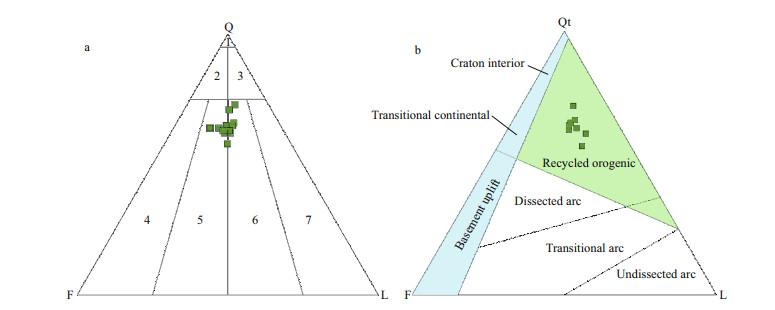
|
| Fig.4 QFL triangle diagram (Folk, 1980) (a) and QtFL diagram (b) (Dickinson, 1970; Dickinson et al., 1983) for the Dalong Formation Q: quartz; F: feldspar; L: lithic grains; 1: quartz arenite; 2: sublitharenite; 3: subarkose; 4: litharenite; 5: feldspathic litharenite; 6: lithic arkose; 7: arkose. The QtFL ternary diagram (b) shows the provenance of the Dalong Formation sandstones (Dickinson et al., 1983). |
The SiO2 contents are relatively stable; two samples have less than 50%, and the other samples range from 62.63% to 80.11% (average 67.27%) (Fig. 5, Supplementary Table S1).

|
| Fig.5 The Harker variation diagrams between major elements of the Dalong Formation sandstones Left: vertical axis: SiO2, horizon axis: TiO2; right: vertical axis: Fe2O3T, horizon axis: MgO. |
The contents of SiO2 and TiO2 (R=-0.59; n=9), Al2O3 (R=-0.33), Fe2O3T (R=-0.11), and MgO (R= -0.84) show negative correlations, implying that quartz and silicate minerals affect the elemental chemical composition of the whole rock to a certain extent, especially Mg and Ti. On the other hand, Al2O3 and TiO2 (R=0.25; n=9) show a positive correlation, suggesting that the compositions of ferromagnesian minerals are correlated in the Dalong Formation sandstones, which has similar correlations between Fe2O3T-MgO (R=0.35) and Fe2O3T-TiO2 (R=0.65). Compared with the average chemical compositions of the upper continental crust (UCC) (Fig. 6), those of the Dalong Formation sandstones are rich in CaO and P 2O5, which suggests that the rocks may contain a large amount of bioclasts. SiO2 is slightly enriched relative to the UCC, while the other major elements are completely depleted, especially TiO2 and Fe2O3T.

|
| Fig.6 Upper continental crust (UCC)-normalized spider plots of the average major oxides (left) and trace elements (right) of the Dalong Formation (Date Rudnick and Gao, 2003) Left: major oxides is the average content of 9 samples. |
According to the major elements, most of the Dalong Formation samples plot in the lithic sandstone and arkose fields (Herron, 1988) (Fig. 7), in coincidence with the QFL results.
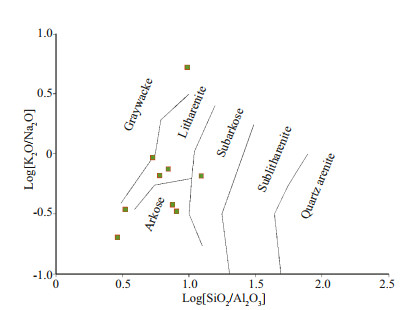
|
| Fig.7 Chemical compositions of the Dalong Formation sandstone plotted on the Pettijohn et al. (1972) diagram |
Compared with the average UCC, in addition to Rb, other large ion lithophile elements such as Ba, Na, and Sr are relatively depleted (Fig. 6). High field strength elements such as Y and Nb are relatively enriched. The total rare earth element contents (ΣREEs) are between 102.73 mg/kg and 211.28 mg/kg (average: 157.87 mg/kg). The light REE (LREE) values range from 101.55 mg/kg to 190.21 mg/kg (average: 139.47 mg/kg), and the heavy REE (HREE) values range from 11.24 mg/kg to 22.86 mg/kg (average: 17.61 mg/kg). The ratio of LREEs/HREEs is between 5.3 and 9 (average 7.9). Compared with the UCC, the Dalong Formation sandstones are obviously more enriched in LREEs than HREEs. Eu anomaly (δEu) values from 0.40 to 0.66 show obvious negative anomalies, and Ce anomaly (δCe) values between 0.86 and 0.99 show weak to very weak negative anomalies.
5 DISCUSSION 5.1 Chemical compositionWith increasing transport distance and other factors, SiO2 is concentrated, and other oxides, including TiO2, Al2O3, MnO, etc., decrease. In other words, there are negative correlations between silica and these other elements (Das et al., 2006). The average major element compositions of the Dalong Formation reflect this feature well (Fig. 5). Due to the weathering of the UCC, elements such as Ca, Na and K are released from feldspar. Hence, compared with UCC, the Dalong Formation sandstones are relatively depleted in Ca and alkali metals. For characteristic crustal elements such as TiO2 and Fe2O3T, significant depletions imply that due to the short transport distance, the UCC materials have not mixed extensively and lack sedimentary recycling. The ferromagnesian trace elements Ni and Co could display generally similar behavior in magmatic processes (Feng and Kerrich, 1990), but the Co and Ni contents of the Dalong Formation are moderately depleted with respect to the average composition of the UCC. These results suggest that there may have been no input of mafic materials from the source terrane.
Hydraulic sorting during sediment transport is now widely considered to cause changes in REE compositions of sediments with different granularities and mineral compositions (Cullers et al., 1975, 1979; Gromet et al., 1984; McLennan, 1989). In the weathering process, REEs are relatively stable. However, the P3d sandstones show no remarkable relationship between REEs and the particle size of sandstones.
5.2 MaturityIn terms of maturity, the purpose of determining rock maturity is to distinguish the reflections of geological conditions, weathering intensity and transport distance in the source area.
Commonly, maturity has been described by the maturity index (MI), which is the ratio of quartz to quartz+feldspar+rock fragments [100×Q/(Q+F+R)] (Bhatia and Crook, 1986). In general, the MI values increase with differences in provenance from andesite (approximately 10) to dacite (approximately 50-60) to sedimentary-metasedimentary rocks (greater than 80). The Q/(Q+F+R) ratios of the Dalong Formation sandstones are between 58 and 73 (average: 63), indicating low to moderate maturity.
In addition to the ratio methods, the maturity of sandstones can be identified by using the index of component variation (ICV) (Cox et al., 1995), which has been successfully applied in many studies (Tao et al., 2013; Armstrong-Altrin et al., 2015). The ICV formulas are as follows:

CaO* that specifically refers only to silicate minerals. Therefore, this paper uses the McLennan et al. (1993) approximate valuation method. If CaO-P2O5 > Na2O, Na2O can be used directly as CaO*; if CaO-P2O5 < Na2O, remain number of CaO is replaced by Na2O as CaO*.
Generally, rock-forming minerals such as feldspars, amphiboles, and pyroxenes have high ICV values (> 1). The values for clay materials such as illite and muscovite are generally lower (< 1). Therefore, compositionally immature sediments with high ICV values are first-cycle deposits, whereas compositionally mature sediments with low ICV values indicate high recycling and intense weathering (Van de Kamp and Leake, 1985). The ICV values of the Dalong Formation sandstones range from 0.6 to 2.6 (average: 1.29), except for one sample (2.69), suggesting that Dalong Formation sandstones have low maturity or are submature and mostly composed of first-cycle rock-forming minerals. The results from the two methods indicate that the transport distance may have been short.
5.3 Tectonic settingDickinson et al. (1983) related detrital sandstone compositions to major provenance types, such as stable cratons, basement uplifts, magmatic arcs and recycled orogens. To illustrate the tectonic discrimination source field, the Dalong Formation sandstones are plotted on the QtFL ternary diagram (Dickinson, 1970; Dickinson et al., 1983) (Fig. 4). According to the diagram, the Dalong Formation sandstones plot in the field of recycled orogenic rocks.
In addition to rock fragments, sandstones produced in different tectonic areas, such as an oceanic island arc (OIA), a continental island arc (CIA), an active continental margin (ACM), and a passive continental margin (PCM), have totally variable chemical compositions.
Bhatia (1983) used ratios of Fe2O3T+MgO, Al2O3/SiO 2, K2O/Na2O and Al2O3/(CaO+Na2O) to distinguish sandstones from different tectonic settings; Roser and Korsch (1986) used the log(K2O/Na2O)-SiO2 diagram to reflect the tectonic environment of land-sourced clastic rocks. However, because of the dynamic chemical properties of Na and K, this illustration must be applied carefully because some elements may migrate during the formation process. Therefore, using a variety of discrimination plots is necessary to accurately reflect the tectonic setting.
The data clusters plot in the ACM field on the log(K2O/Na2O)-SiO2 diagram. The points for the Dalong Formation sandstones mainly plot in the lower parts of the ACM and PCM fields on the TiO 2-(Fe2O3T-MgO) diagram, indicating low concentrations of TiO2 in the source area. Most of the sample points are also in similar positions on the Al2O3/SiO2-(Fe2O3T-MgO) diagram, with very few exceptions. Using diagrams such as La-Th-Sc, Th-Sc-Zr/10, La/Y-Sc/Cr (Bhatia and Crook, 1986) (Fig. 8) and other element ratios (Table 4), most of the Dalong Formation sandstones plot in the ACM and PCM fields. These results suggest that the provenance of the South Yellow Sea Basin rocks may have transformed from a PCM to an ACM during the Permian.
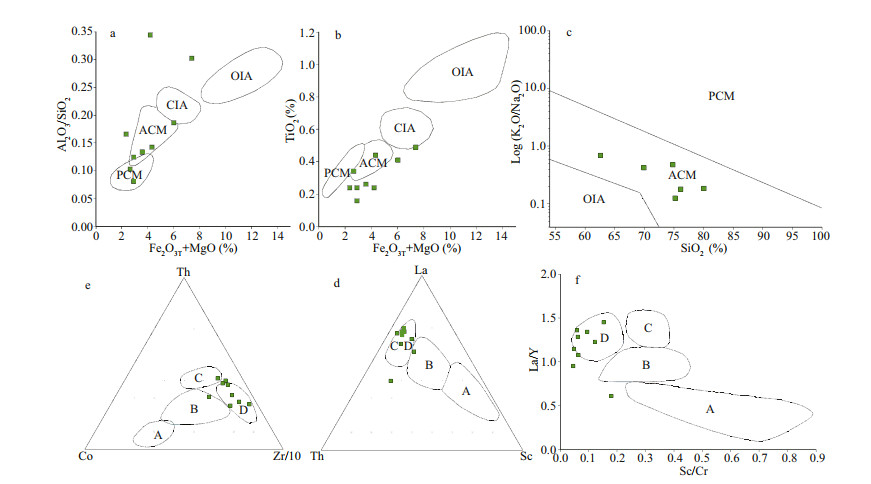
|
| Fig.8 Tectonic setting discrimination diagrams for the Dalong Formation sandstones a, b. Bhatia, 1983; c. Roser and Korsch, 1986; d, e, and f. Bhatia and Crook, 1986. A and OIA: oceanic island arc; B and CIA: continental island arc; C and ACM: active continental margin; D and PCM: passive continental margin. |

|
Chemical weathering has a great influence on the abundance of elements that originate mainly from source area materials. Importantly, tracing the characteristics of the source rock can recover the chemical weathering history. Sedimentary rock weathering can be evaluated by the chemical index of alteration (CIA) (Nesbitt and Young, 1982) and the plagioclase index of alteration (PIA) (Fedo et al., 1995). The weathering intensity and duration for sedimentary rocks can be evaluated by studying the relationship between alkaline substances and alkaline soil elements (Nesbitt and Young 1982). During this process, siliceous compositions are relatively abundant. The weathering conditions of the source area can generally be judged by the CIA, which has been successfully used in many studies (Armstrong-Altrin et al., 2015; Rashid et al., 2015; Tawfik et al., 2017a, b).

Among them, all oxide contents are calculated using molar fractions, CaO* is calculated by the same formula as the ICV calculation.
Higher CIA values (> 80) indicate stronger chemical weathering (Nesbitt and Young, 1982; Fedo et al., 1995), while lower CIA values (50-60) indicate the beginning of chemical weathering or weaker weathering. Focusing on the CIA values of the Dalong Formation sandstones, six of the nine samples fall between 50 and 60 (remainder: 1 greater than 70 and 2 less than 50), which indicates that Dalong Formation sandstones are mainly in the stage of initial weathering or weak weathering. Similarly, the PIA values for the Dalong Formation sandstones range from 33 to 83 (average: 57), also suggesting weak weathering in the source area. The relatively large values of CIA and PIA are speculated to be related to the low contents of alkali elements from the parent rocks.
However, CIA values are supposed to be lower than the actual values because of potassium metasomatism during diagenesis. Therefore, using the ternary diagram Al2O3-(CaO-Na2O)-K2O (A-CN-K) (Nesbitt and Young, 1982) (Fig. 9) is necessary to correct the CIA values more accurately (Fedo et al., 1995). In the early weathering stage, sedimentary materials from different types of rocks are mainly parallel to the A-CN line. With increasing degrees of weathering, plagioclase and K-feldspar in the source rock are dissolved. This process causes the loss of Ca+ and Na+ from plagioclase and K+ from K-feldspar. Sediments that have experienced weathering plot close to the A axis, where kaolinite is the main composition among minerals such as feldspar. In the A-CN-K diagram, the data clusters are found to be close to the A-CN line, indicating the trend of chemical weathering. The distance from the line to the sample points suggests that the chemical weathering was rather weak and that the source area of the Dalong Formation sandstones was not far.
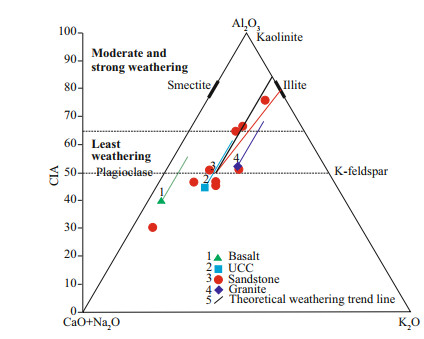
|
| Fig.9 A-CN-K diagram showing the weathering trend of the Dalong Formation. Weathering trends 1-4: basalt and UCC (Condie, 1993); granite and granodiorite (Jayananda et al., 2000). |
Generally, depositional recycling can be reflected by the Th/U ratio (McLennan et al., 1980, 1990; McLennan and Taylor, 1991). The values of the Th/U ratio are assumed to increase because weathering and sedimentary recycling lead to oxidation and the loss of uranium. Uranium concentrations in the original locations cause the values of Th/U to decrease (McLennan et al., 1980, 1990; McLennan and Taylor, 1991). The values of the Th/U ratio vary from 2.03 to 4.81 (n=9; average: 3.56). The average value of the Th/U ratio in UCC igneous rocks is approximately 3.8 (McLennan et al., 1980, 1990; Taylor and McLennan, 1985; McLennan and Taylor, 1991; Condie, 1993; McLennan, 2001). The values in the Dalong Formation are close to that in the UCC. The results from CIA values and Th/U ratios indicate that the Dalong Formation sandstones originate mainly from areas with weak weathering.
5.5 ProvenanceThe composition of sandstones is greatly affected by the source area. Roser and Korsch (1988) used a major element-based provenance discrimination diagram (Fig. 10) to distinguish source areas such as mafic rock, intermediate rock, felsic rock, and recycled quartzose rock. This diagram has been widely applied to the study of the parent rocks of clastic rocks (Armstrong-Altrin et al., 2015; Zaid et al., 2015a, b; Armstrong-Altrin and Machain-Castillo, 2016; Tawfik et al., 2017a, b). The Dalong Formation sandstones (n=9) mainly plot in the quartz sediment source area on the provenance discriminant function plot.
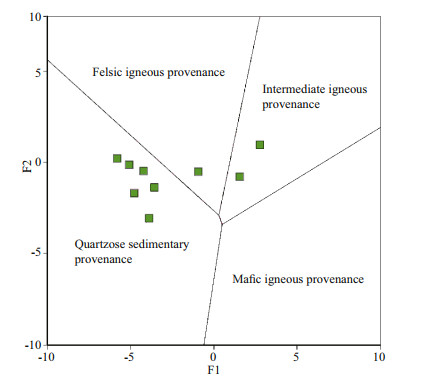
|
|
Fig.10
Provenance discrimination diagram of Roser and Korsch (1988) for the Dalong Formation sandstones
F1=-1.773TiO2+0.607Al2O3+0.76Fe2O3T-1.5MgO+0.616CaO+ 0.509Na2O-1.224K2O-0.909;
F2=0.445TiO2+0.07Al2O3-0.25Fe2O3T-1.142MgO-0.438CaO+ 0.475Na2O+1.426K2O-6.681. |
In addition to this diagram, the oxidizing materials Al2O3 and TiO2 are considered stable during the processes of weathering, deposition, and material transport. Therefore, the A12O3/TiO2 ratio has widely been used to study the parent rock composition (Absar and Sreenivas, 2015; Armstrong-Altrin, et al., 2015; Zhou et al., 2015). These ratio values increase from 3-8 (mafic) to 8-21 (intermediate) and 21-70 (felsic) in igneous rocks. The A12O3/TiO2 ratios (21-89; average: 39) of the Dalong Formation sandstones fall mainly in the range of felsic igneous rock areas.
Elements such as Cr, Ni, Th, and REEs and the ratio Cr/Ni are reliable indicators to determine the source rock (Armstrong-Altrin et al., 2004) because Cr and Ni are more concentrated in mafic than in felsic igneous rocks, whereas the abundances of Th and REE are higher in felsic igneous rocks and their weathering products. The low concentrations of Cr and Ni (Cr < 91×10-6, and Ni < 20×10-6) and the high ratios of Cr/Ni (2.7-7.8; average 5.1) indicate that there were minimal mafic igneous rocks in the source area (Garver et al., 1996). At the same time, other element ratios, such as Cr/Th, Th/Co, Th/Cr, and La/Co, can also reflect the characteristics of the original source area (Cox et al., 1995; Cullers, 2000; Armstrong-Altrin et al., 2015). By comparison, the values of Eu/Eu*, La/Sc, Th/Sc, La/Co, Th/Co, and Cr/Th (Table 5) are closer to those in felsic igneous rocks.
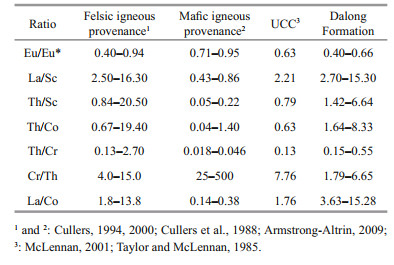
|
Additionally, the REE distribution patterns and the values of δEu are used to infer the provenance of sedimentary rocks (Taylor and McLennan 1985; Wronkiewicz and Condie, 1989). In general, felsic igneous rocks show higher values of LREE/HREE and negative Eu anomalies. In contrast, lower ratios of LREE/HREE and minimal negative Eu anomalies can be found in mafic igneous rocks (Cullers, 1994, 2000). The LREE/HREE ratios for barite or granodiorite and fused eclogite may be very large and have no Eu anomalies. For the Dalong Formation sandstones, high LREE/HREE (5-9; average 7.9; n=9) and strong negative Eu anomalies (0.4-0.6; average 0.57; n=9) suggest that the materials were derived from felsic igneous rocks.
Based on previous studies, the basement of the Yangtze Plate consists of metamorphic rocks formed by an arc-continent collision at 800 Ma (Huang, 1960; Pan et al., 2016). After detaching from ancient land in the Southern Hemisphere, the Yangtze Plate continued to move northward until it collided with the Cathyasian Plate and the North China Plate during the Paleozoic era. The paleotectonic settings and geochemical results indicate that the provenance of the Dalong Formation sandstones might have been a felsic igneous source with components from ancient sedimentary sources.
5.6 Diagenetic evolutionBased on petrography and geochemistry, the sedimentary diagenesis process of Dalong Formation sandstones can be divided into three main phases: early, middle and late diagenesis. For the sandstones of the Dalong Formation, the main framework grains are monocrystalline quartz, followed by feldspar or lithic fragments. Then, finding an illite/chlorite mixed layer in clay minerals is notable, because they have been considered structurally unstable (Ahn et al., 1988). In addition, sandstones of the Dalong Formation are very dense (Cai et al., 2020).
Early diagenesis started with the dissolution of unstable components such as feldspars, micas, and heavy minerals from areas with felsic rocks and ancient sedimentary rocks. Most of the minerals were preserved as rock components after weak weathering. Meanwhile, not much crustal material was mixed in due to the short transport distance. Most mineral sizes and shapes changed during transport. When unstable minerals dissolved, they released cations such as K+, Na+, Ca2+, Al3+, Si4+, Mg2+, Fe3+, and other elements, which were the main sources for diagenetic materials.
During middle diagenesis, mechanical compaction caused a reduction in primary depositional porosity, dewatering, and rearrangement of grain fabrics with rapid sedimentation. Pressure, temperature and alkaline interstitial fluids caused dissolution of remnant feldspars and other grains, which provided the main materials for clay minerals such as illite and chlorite. Meanwhile, these factors resulted in the development of secondary porosity (Salah et al., 2016). Calcite and dolomite cements formed by the precipitation of early calcareous materials. The grains of limestone, dolomite and clay minerals replaced detrital feldspar grains and filled some primary and secondary pores previously created by dissolution of framework grains. At this stage, smectites from the weathering of felsic rocks or kaolinites from the dissolution and precipitation of feldspars were transformed into fibrous illite (Ramm and Ryseth, 1996). Some kaolinites were transformed into chlorite. The fibrous, hair-like spiny terminations of illite indicated a diagenetic origin (Lemon and Cubitt, 2003). This transformation occurred at temperatures greater than 70 ℃ but became pervasive at temperatures greater than 130 ℃ (Bjφrlykke and Aagaard, 1992). The deeper burial did not last for a long time based on the presence of unstable illite/chlorite mixed layers.
During the final stage, dissolution of feldspars released silica that may have precipitated, providing the material source for secondary enlargement of early quartz. With further increases in pressure and other factors, cracks occurred at the edges of quartz grains and were filled by pre-existing illite.
6 CONCLUSIONThe petrographic study of the Dalong Formation sandstones shows that they consist mostly of feldspar litharenite and lithic arkose. In addition, the rock geochemistry supports the petrographic results.
The CIA values indicate a low degree of weathering in the source area for the Dalong Formation. The low CIA values of Dalong Formation sandstones indicate short transport of the original active continental margin and passive continental margin minerals into the depositional system. The variations in chemical weathering are probably due to the sorting effect during deposition.
The provenance of the Dalong Formation sandstones was assessed using integrated petrographical and geochemical studies. The results suggest the influence of felsic and quartzose terranes as the main source rocks, with limited recycling of sediments. The interpretation of geochemical data based on discrimination function diagrams reveals that the source materials came from an ACM and a PCM tectonic setting. These origins can be attributed to the northward movement of the Lower Yangtze Plate and the collision between the Lower Yangtze Plate and the North China Plate. In other words, the provenance of Dalong Formation sandstones may have changed over the whole course of deposition. The compositional maturity of the Dalong Formation sandstones is relatively low.
The Dalong Formation sandstones show three phases of diagenetic alteration. A variety of factors, including mechanical compaction, cementation, feldspar dissolution, and metasomatism, played important roles in the diagenetic stages.
7 DATA AVAILABILITY STATEMENTThe data that support the findings of this study are available on request from the corresponding author Prof. GUO. The data are not publicly available as they contain information that could compromise research participant privacy.
Electronic supplementary materialSupplementary material (Supplementary Table S1) is available in the online version of this article at https://doi.org/10.1007/s00343-020-0155-x.
Absar N, Sreenivas B. 2015. Petrology and geochemistry of greywackes of the ~1.6 Ga Middle Aravalli Supergroup, northwest India: evidence for active margin processes. International Geology Review, 57(2): 134-158.
DOI:10.1080/00206814.2014.999355 |
Ahn J H, Peacor D R, Coombs D S. 1988. Formation mechanisms of illite, chlorite and mixed-layer illite-chlorite in Triassic volcanogenic sediments from the Southland Syncline, New Zealand. Contributions to Mineralogy and Petrology, 99(1): 82-89.
DOI:10.1007/BF00399368 |
Armstrong-Altrin J S, Lee Y I, Verma S P, Ramasamy S. 2004. Geochemistry of sandstones from the Upper Miocene Kudankulam Formation, southern India: implications for provenance, weathering, and tectonic setting. Journal of Sedimentary Research, 74(2): 285-297.
DOI:10.1306/082803740285 |
Armstrong-Altrin J S, Lee Y I, Verma S P, Worden R H. 2009. Carbon, oxygen, and strontium isotope geochemistry of carbonate rocks of the upper miocene kudankulam formation, southern india: implications for paleoenvironment and diagenesis. Chemie der Erde - Geochemistry - Interdisciplinary Journal for Chemical Problems of the Geosciences and Geoecology, 69(1): 45-60.
|
Armstrong-Altrin J S, Machain-Castillo M L, Rosales-Hoz L, Carranza-Edwards A, Sanchez-Cabeza J A, Ruíz-Fernandez A C. 2015. Provenance and depositional history of continental slope sediments in the southwestern Gulf of Mexico unraveled by geochemical analysis. Continental Shelf Research, 95: 15-26.
DOI:10.1016/j.csr.2015.01.003 |
Armstrong-Altrin J S, Machain-Castillo M L. 2016. Mineralogy, geochemistry, and radiocarbon ages of deep sea sediments from the Gulf of Mexico, Mexico. Journal of South American Earth Sciences, 71: 182-200.
DOI:10.1016/j.jsames.2016.07.010 |
Armstrong-Altrin J S, Ramasamy S, Makhnach A. 2001. Stable isotope geochemistry and evidence for meteoric diagenesis in Kudankulam Formation, Tamil Nadu. Geological Society of India Journal, 57: 39-48.
|
Armstrong-Altrin J S. 2015. Evaluation of two multidimensional discrimination diagrams from beach and deep-sea sediments from the Gulf of Mexico and their application to Precambrian clastic sedimentary rocks. International Geology Review, 57(11-12): 1 446-1 461.
DOI:10.1080/00206814.2014.936055 |
Berner R A. 1991. A model for atmospheric CO2 over Phanerozoic time. American Journal of Science, 291(4): 339-376.
DOI:10.2475/ajs.291.4.339 |
Bhatia M R, Crook K A W. 1986. Trace element characteristics of graywackes and tectonic setting discrimination of sedimentary basins. Contributions to Mineralogy and Petrology, 92(2): 181-193.
DOI:10.1007/BF00375292 |
Bhatia M R. 1983. Plate tectonics and geochemical composition of sandstones. Journal of Geology, 91(6): 611-627.
DOI:10.1086/628815 |
Bjφrlykke K, Aagaard P. 1992. Clay minerals in North Sea Sandstones. Origin, Diagenesis, and Petrophysics of Clay Minerals in Sandstones. In: Houseknecht D W, Pittrnan E D eds. SEPM Special Publication, 47: 65-80.
|
Cai L X, Guo X W, Zhang X H, Zeng Z G, Xiao G L, Pang Y M, Wang S P. 2020. Pore-throat structures of the Permian Longtan Formation tight sandstones in the South Yellow Sea Basin, China: a case study from borehole CSDP-2. Journal of Petroleum Science and Engineering, 186: 106733.
DOI:10.1016/j.petrol.2019.106733 |
Cai L X, Xiao G L, Guo X W, Wang J, Wu Z Q, Li B G. 2019. Assessment of Mesozoic and Upper Paleozoic source rocks in the South Yellow Sea Basin based on the continuous borehole CSDP-2. Marine and Petroleum Geology, 101: 30-42.
DOI:10.1016/j.marpetgeo.2018.11.028 |
Condie K C. 1993. Chemical composition and evolution of the upper continental crust: contrasting results from surface samples and shales. Chemical Geology, 104(1-4): 1-37.
DOI:10.1016/0009-2541(93)90140-E |
Cox R, Lowe D R, Cullers R L. 1995. The influence of sediment recycling and basement composition on evolution of mudrock chemistry in the southwestern United States. Geochimica et Cosmochimica Acta, 59(4): 2 919-2 940.
|
Cullers R L, Basu A, Sutter L J. 1988. Geochemical signature of provenance in sand-size material in soils and stream sediments near the Tobacco Root batholith, Montana, USA. Chemical Geology, 70: 335-348.
DOI:10.1016/0009-2541(88)90123-4 |
Cullers R L, Chaudhuri S, Arnold B, Lee M, Wolf C W Jr. 1975. Rare earth distributions in clay minerals and in the clay-sized fraction of the Lower Permian Havensville and Eskridge shales of Kansas and Oklahoma. Geochimica et Cosmochimica Acta, 39(12): 1 691-1 703.
DOI:10.1016/0016-7037(75)90090-3 |
Cullers R L. 1994. The controls on the major and trace element variation of shales, siltstones, and sandstones of Pennsylvanian-Permian age from uplifted continental blocks in Colorado to platform sediment in Kansas, USA. Geochimica et Cosmochimica Acta, 58(22): 4 955-4 972.
DOI:10.1016/0016-7037(94)90224-0 |
Cullers R L. 2000. The geochemistry of shales, siltstones and sandstones of Pennsylvanian-Permian age, Colorado, USA: implications for provenance and metamorphic studies. Lithos, 51(3): 181-203.
DOI:10.1016/S0024-4937(99)00063-8 |
Cullers R, Chaudhuri S, Kilbane N, Koch R. 1979. Rare-earths in size fractions and sedimentary rocks of Pennsylvanian-Permian age from the mid-continent of the U.S.A. Geochimica et Cosmochimica Acta, 43(8): 1 285-1 301.
DOI:10.1016/0016-7037(79)90119-4 |
Dai C S. 2011. Oil Gas Basin Group of China Seas and Early Resource Assessment Techniques. Ocean Press, Beijing, China. p.85-86.
(in Chinese)
|
Das B K, Al-Mikhlafi A S, Kaur P. 2006. Geochemistry of Mansar lake sediments, Jammu, India: implication for source-area weathering, provenance, and tectonic setting. Journal of Asian Earth Sciences, 26(6): 649-668.
DOI:10.1016/j.jseaes.2005.01.005 |
Dickinson W R, Beard L S, Brakenridge G R, Erjavec J L, Ferguson R C, Inman K F, Knepp R A, Lindberg F A, Ryberg P T. 1983. Provenance of North American Phanerozoic sandstones in relation to tectonic setting. GSA Bulletin, 94(2): 222-235.
DOI:10.1130/0016-7606(1983)94<222:PONAPS>2.0.CO;2 |
Dickinson W R. 1970. Interpreting detrital modes of graywacke and arkose. Journal of Sedimentary Research, 40(2): 695-707.
|
Etemad-Saeed N, Hosseini-Barzi M, Adabi M H, Miller N R, Sadeghi A, Houshmandzadeh A, Stockli D F. 2016. Evidence for ca. 560 Ma Ediacaran glaciation in the Kahar formation, central Alborz Mountains, northern Ira. Gondwana Research, 31: 164-183.
DOI:10.1016/j.gr.2015.01.005 |
Fedo C M, Nesbitt H W, Young G M. 1995. Unraveling the effects of potassium metasomatism in sedimentary rocks and paleosols, with implications for paleoweathering conditions and provenance. Geology, 23(10): 921-924.
DOI:10.1130/0091-7613(1995)023<0921:UTEOPM>2.3.CO;2 |
Feng R, Kerrich R. 1990. Geochemistry of fine-grained clastic sediments in the Archean Abitibi greenstone belt, Canada: implications for provenance and tectonic setting. Geochimica et Cosmochimica Acta, 54(4): 1 061-1 081.
DOI:10.1016/0016-7037(90)90439-R |
Folk R L. 1980. Petrology of Sedimentary Rocks. Hemphill Publishing Company, Austin. p. 45-50.
|
Garver J I, Royce P R, Smick T A. 1996. Chromium and nickel in shale of the Taconic Foreland: A case study for the provenance of fine-grained sediments with an ultramafic source. Journal of Sedimentary Research, 66: 100-106.
|
Goddéris Y, Donnadieu Y, Le Hir G, Lefebvre V, Nardin E. 2014. The role of palaeogeography in the Phanerozoic history of atmospheric CO2 and climate. Earth-Science Reviews, 128: 122-138.
DOI:10.1016/j.earscirev.2013.11.004 |
Gromet L P, Haskin L A, Korotev R L, Dymek R F. 1984. The "North American shale composite": its compilation, major and trace element characteristics. Geochimica et Cosmochimica Acta, 48(12): 2 469-2 482.
DOI:10.1016/0016-7037(84)90298-9 |
Guo X W, Xu H H, Zhu X Q, Pang Y M, Zhang X H, Lu H N. 2017. Discovery of Late Devonian plants from the southern Yellow Sea borehole of China and its palaeogeographical implications. Palaeogeography, Palaeoclimatology, Palaeoecology, 531: 108444.
|
Hao T Y, Huang S, Xu Y, Li Z W, Zhang L L, Wang J L, Suh M, Kim K. 2010. Geophysical understandings on deep structure in Yellow Sea. Chinese Journal of Geophysics, 53(6): 1 315-1 326.
(in Chinese with English abstract) |
Herron M M. 1988. Geochemical classification of terrigenous sands and shales from core or log data. Journal of Sedimentary Petrology, 58(5): 820-829.
|
Hou F H, Zhang Z X, Zhang X H, Li S Z, Li G, Guo X W, Tian Z X. 2008. Geologic evolution and tectonic styles in the South Yellow Sea Basin. Marine Geology & Quaternary Geology, 28(5): 61-68.
(in Chinese with English abstract) |
Huang T K. 1960. The main characteristics of the geologic structure of China: preliminary conclusions. Acta Geologica Sinica, 40(1): 32-37.
|
Jayananda M, Moyen J F, Martin H, Peucat J J, Auvray B, Mahabaleswar B. 2000. Late Archaean (2550-2520 Ma) juvenile magmatism in the eastern Dharwar craton, Southern India: constraints from geochronology, Nd-Sr isotopes and whole rock geochemistry. Precambrian Research, 99(3-4): 225-254.
DOI:10.1016/S0301-9268(99)00063-7 |
Jiang N Y, Jia R F, Wang Z Y, Qi D, Yu Z, He Y, Zhu Z L. 1994. Permian Palaeogeography and Geochemical Environment in Lower Yangtze Region, China. Petroleum Industry Press, Beijing, China. p.15-47.
(in Chinese)
|
Jin Y G, Shang Q H, Cao C Q. 2000. A review of Permian stratigraphy. Journal of Stratigraphy, 24(2): 99-108.
(in Chinese with English abstract) |
Johnsson M J, Basu A. 1993. Processes Controlling the Composition of Clastic Sediments. Geological Society of America, Boulde. 342p.
|
Lemon N M, Cubitt C J. 2003. Illite fluorescence microscopy: a new technique in the study of illite in the Merrimelia Formation, Cooper Basin, Australia. In: Worden R H, Morad S eds. Clay Mineral Cements in Sandstones. International Association of Sedimentologists, Malden. p. 411-424.
|
Liang D G, Guo T L, Chen J P, Bian L Z, Zhao Z. 2008. Some progresses on studies of hydrocarbon generation and accumulation in marine sedimentary regions, Southern China (Part 1): distribution of four suits of regional marine source rocks. Marine Origin Petroleum Geology, 13(2): 1-16.
(in Chinese with English abstract) |
McLennan S M, Hemming S, McDaniel D K, Hanson G N. 1993. Geochemical approaches to sedimentation, provenance, and tectonics. In: Johnsson M J, Basu A eds. Processes Controlling the Composition of Clastic Sediments. Geological Society of America, London. p. 21-40.
|
McLennan S M, Nance W B, Taylor S R. 1980. Rare earth element-thorium correlations in sedimentary rocks, and the composition of the continental crust. Geochimica et Cosmochimica Acta, 44(11): 1 833-1 839.
DOI:10.1016/0016-7037(80)90232-X |
McLennan S M, Taylor S R, McCulloch M T, Maynard J B. 1990. Geochemical and Nd-Sr isotopic composition of deep-sea turbidites: crustal evolution and plate tectonic associations. Geochimica et Cosmochimica Acta, 54(7): 2 015-2 050.
DOI:10.1016/0016-7037(90)90269-Q |
McLennan S M, Taylor S R. 1991. Sedimentary rocks and crustal evolution: tectonic setting and secular trends. The Journal of Geology, 99(1): 1-21.
DOI:10.1086/629470 |
McLennan S M. 1989. Rare earth elements in sedimentary rocks: influence of provenance and sedimentary processes. Reviews in Mineralogy and Geochemistry, 21(1): 169-200.
|
McLennan S M. 2001. Relationships between the trace element composition of sedimentary rocks and upper continental crust. Geochemistry, Geophysics, Geosystems, 2(4): 2000GC000109.
|
Nesbitt H W, Young G M. 1982. Early Proterozoic climates and plate motions inferred from major element chemistry of lutites. Nature, 299(5885): 715-717.
DOI:10.1038/299715a0 |
Pan G T, Lu S N, Xiao Q H, Zhang K X, Yin F G, Hao G J, Luo M S, Ren F, Yuan S H. 2016. Division of tectonic stages and tectonic evolution in China. Earth Science Frontiers, 23(6): 1-23.
(in Chinese with English abstract) |
Pang Y M, Guo X W, Han Z Z, Zhang X H, Zhu X Q, Hou F H, Han C, Song Z G, Xiao G L. 2019. Mesozoic-Cenozoic denudation and thermal history in the Central Uplift of the South Yellow Sea basin and the implications for hydrocarbon systems: constraints from the CSDP-2 borehole. Marine and Petroleum Geology, 99: 355-369.
DOI:10.1016/j.marpetgeo.2018.10.027 |
Pang Y M, Zhang X H, Guo X W, Xiao G L, Han Z Z. 2017a. Basin modeling in the initial stage of exploration: a case study from the north subbasin of the south Yellow Sea Basin. Acta Oceanologica Sinica, 36(9): 65-78.
DOI:10.1007/s13131-017-1112-1 |
Pang Y M, Zhang X H, Guo X W, Xiao G L, Zhu X Q. 2017b. Mesozoic and Cenozoic tectono-thermal evolution modeling in the northern South Yellow Sea Basin. Chinese Journal of Geophysics, 60(8): 3 177-3 190.
(in Chinese with English abstract) |
Pettijohn F J, Potter P E, Siever R. 1972. Sand and Sandstone. Springer, New York, https: //doi.org/10.1007/978-1-4615-9974-6.
|
Ramm M, Ryseth A E. 1996. Reservoir quality and burial diagenesis in the Statfjord Formation, North Sea. Petroleum Geoscience, 2(4): 313-324.
DOI:10.1144/petgeo.2.4.313 |
Rashid S A, Gana I J A, Masoodi A, Khan F A. 2015. Major and trace element geochemistry of lake sediments, India: Implications for weathering and climate control. Arabian Journal of Geosciences, 8: 10 481-10 496.
DOI:10.1007/s12517-015-1982-5 |
Roser B P, Korsch R J. 1986. Determination of tectonic setting of sandstone-mudstone suites using SiO2 content and K2O/Na2O ratio. The Journal of Geology, 94(5): 635-650.
DOI:10.1086/629071 |
Roser B P, Korsch R J. 1988. Provenance signatures of sandstone-mudstone suites determined using discriminant function analysis of major-element data. Chemical Geology, 67(1-2): 119-139.
DOI:10.1016/0009-2541(88)90010-1 |
Rudnick R L, Gao S. 2003. Composition of the continental crust. In: Holland H D, Turekian K K eds. Treatise on Geochemistry. Elsevier, Amsterdam. p. 1-64.
|
Salah M K, El Ghandour M M, Abdel-Hameed A T. 2016. Effect of diagenesis on the petrophysical properties of the Miocene rocks at the Qattara Depression, north Western Desert, Egypt. Arabian Journal of Geosciences, 9(5).
DOI:10.1007/s12517-015-2275-8 |
Salama W, Anand R R. 2017. Reconstructing the pre-Quaternary landscape in Agnew-Lawlers area, Western Australia with emphasis on the Permo-Carboniferous glaciation and post-glacial weathering. International Journal of Earth Sciences, 106(1): 311-339.
DOI:10.1007/s00531-016-1320-5 |
Tao H F, Sun S, Wang Q C, Yang X F, Jiang L. 2013. Provenance and tectonic setting of Late Carboniferous clastic rocks in West Junggar, Xinjiang, China: a case from the Hala-alat Mountains. Journal of Asian Earth Sciences, 64: 210-222.
DOI:10.1016/j.jseaes.2012.12.019 |
Tawfik H A, Ghandour I M, Maejima W, Abdel-Hameed A T. 2011. Petrography and geochemistry of the Lower Paleozoic Araba Formation, northern Eastern Desert, Egypt: Implications for provenance, tectonic setting and weathering signature. Journal of Geoscience, 54: 1-16.
|
Tawfik H A, Ghandour I M, Maejima W, Abdel-Hameed A T. 2012. Petrochemistry of the Lower Cambrian Araba Formation, Taba Area, East Sinai, Egypt. AAPG (American Association of Petroleum Geologists) Annual Convention and Exhibition. Long Beach, California, USA.
|
Tawfik H A, Ghandour I M, Maejima W, Armstrong-Altrin J S, Abdel-Hameed A M T. 2017a. Petrography and geochemistry of the siliciclastic Araba Formation (Cambrian), east Sinai, Egypt: implications for provenance, tectonic setting and source weathering. Geological Magazine, 154(1): 1-23.
DOI:10.1017/S0016756815000771 |
Tawfik H A, Salah M K, Maejima W, Armstrong-Altrin J S, Abdel-Hameed A M T, El Ghandour M M. 2017b. Petrography and geochemistry of the Lower Miocene Moghra sandstones, Qattara Depression, north Western Desert, Egypt. Geological Journal, 53(5): 1 938-1 953.
|
Taylor S R, McLennan S M. 1985. The Continental Crust: its Composition and Evolution. Blackwell, Oxford.
|
Van de Kamp P C, Leake B E. 1985. Petrography and geochemistry of feldspathic and mafic sediments of the northeastern Pacific margin. Earth and Environmental Science Transactions of the Royal Society of Edinburgh, 76(4): 411-449.
DOI:10.1017/S0263593300010646 |
Verma S P, Armstrong-Altrin J S. 2016. Geochemical discrimination of siliciclastic sediments from active and passive margin settings. Sedimentary Geology, 332: 1-12.
DOI:10.1016/j.sedgeo.2015.11.011 |
Wang M J, Zhang X H, Wang A G, Xiao G L, Wang J. 2014. Depositional facies of Longtan and Dalong Formations in the southern depression of South Yellow sea basin. Marine Geology Frontiers, 30(7): 46-50, 65.
(in Chinese with English abstract) |
Wronkiewicz D J, Condie K C. 1989. Geochemistry and provenance of sediments from the Pongola Supergroup, South Africa: evidence for a 3.0-Ga-old continental craton. Geochimica et Cosmochimica Acta, 53(7): 1 537-1 549.
DOI:10.1016/0016-7037(89)90236-6 |
Xu H, Zhang H Y, Zhang B L, Yan G J, Shi J, Yang Y Q, Sun H Q, Li J W, Dong G, Lu S S. 2015. Characteristics of the 26 wells from the South Yellow Sea Basin. Marine Geology Frontiers, 31(4): 1-6.
(in Chinese with English abstract) |
Xu M, Chen J W, Lei B H, Shi J, Liu H. 2019. Tectonic background of Mesozoic foreland basin development in the Southern Yellow Sea. Geoscience, 33(1): 13-24.
(in Chinese with English abstract) |
Xu X S. 1997. Stratigraphy (Lithostratic) of Jiangsu Province. University of Geosciences Press, Beijing, China. p.46-79.
(in Chinese)
|
Zachos J C, Opdyke B N, Quinn T M, Jones C E, Halliday A N. 1999. Early Cenozoic glaciation, Antarctic weathering, and seawater 87Sr/86Sr: is there a link?. Chemical Geology, 161(1-3): 165-180.
DOI:10.1016/S0009-2541(99)00085-6 |
Zaid S M. 2015a. Geochemistry of sandstones from the Pliocene Gabir Formation, north Marsa Alam, Red Sea, Egypt: implication for provenance, weathering and tectonic setting. Journal of African Earth Sciences, 102: 1-17.
DOI:10.1016/j.jafrearsci.2014.10.016 |
Zaid S M. 2015b. Integrated petrographic, mineralogical, and geochemical study of the Late Cretaceous-Early Tertiary Dakhla Shales, Quseir-Nile Valley Province, central Egypt: implications for source area weathering, provenance, and tectonic setting. Arabian Journal of Geosciences, 8(11): 9 237-9 259.
DOI:10.1007/s12517-015-1875-7 |
Zhang H Q, Chen J W, Li G, Wu Z Q, Zhang Y G. 2009. Discovery from Seismic Survey in Laoshan Uplift of the South Yellow Sea and the Significance. Marine Geology & Quaternary Geology, 29(3): 107-113.
(in Chinese with English abstract) |
Zhang X H, Guo X W, Wu Z Q, Xiao G L, Zhang X H, Zhu X Q. 2019. Preliminary results and geological significance of Well CSDP-2 in the Central Uplift of South Yellow Sea Basin. Chinese Journal of Geophysics, 62(1): 197-218.
(in Chinese) |
Zhang X H, Zhang Z X, Lan X H, Li R H. 2013. Regional Geology of the South Yellow Sea. Ocean Press, Beijing. p.1-23.
(in Chinese)
|
Zhou L L, Friis H, Poulsen M L K. 2015. Geochemical evaluation of the Late Paleocene and Early Eocene shales in Siri Canyon, Danish-Norwegian Basin. Marine and Petroleum Geology, 61: 111-122.
DOI:10.1016/j.marpetgeo.2014.12.014 |
 2021, Vol. 39
2021, Vol. 39



